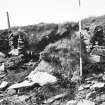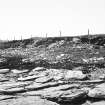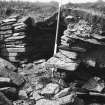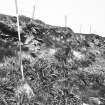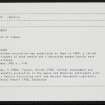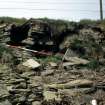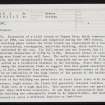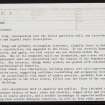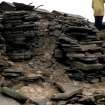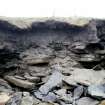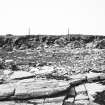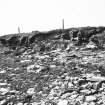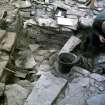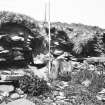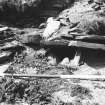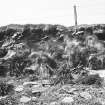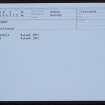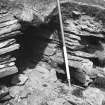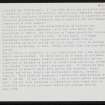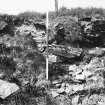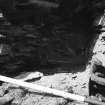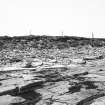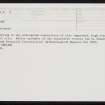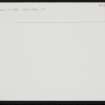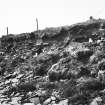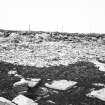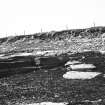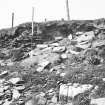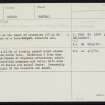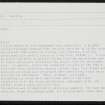Following the launch of trove.scot in February 2025 we are now planning the retiral of some of our webservices. Canmore will be switched off on 24th June 2025. Information about the closure can be found on the HES website: Retiral of HES web services | Historic Environment Scotland
Westray, Tuquoy
Midden (Viking) - (Norse), Settlement (Viking) - (Norse)
Site Name Westray, Tuquoy
Classification Midden (Viking) - (Norse), Settlement (Viking) - (Norse)
Alternative Name(s) Crosskirk; Cross-kirk; Ness Of Tuquoy
Canmore ID 2822
Site Number HY44SE 5
NGR HY 4546 4313
Datum OSGB36 - NGR
Permalink http://canmore.org.uk/site/2822
- Council Orkney Islands
- Parish Westray
- Former Region Orkney Islands Area
- Former District Orkney
- Former County Orkney
Tuquoy, Westray, Orkney, rune-inscribed stone
Measurements: L 0.77m, W 0.41m, H 0.11m
Stone type: flagstone
Place of discovery: HY 4546 4313
Present location: HES store, Edinburgh.
Evidence for discovery: found 1982-3 during excavation of a late Norse settlement, reused as a building stone.
Present condition: worn.
Description
Along the narrow face of the slab are lightly incised runes, representing a graffito inscription.
Date: early medieval.
References: Barnes & Page 2006, OR 14, 197-200.
Compiled by A Ritchie 2017
HY44SE 5 4546 4313.
A kitchen-midden on the beach at Crosskirk (HY44SE 1) yielded a fragment of a bowl-shaped, steatite urn.
J G Callander 1930.
At HY 4546 4313 c.12.0m of closely packed burnt stones are exposed in the shore line. Extending W from them for c.60m are the traces of drystone structures, exhibiting signs of lintelled passages and cells, with some midden material of shells and animal bones. Presumably the source of origin of the steatite urn sherd.
Visited by OS(AA) 4 July 1970.
HY 454 431. Excavation of a trial trench on Tuquoy farm, which commenced in the summer of 1982, was continued and completed during the 1983 season. The earliest building phase within the trial trench was represented by a long and massively constructed, rectangular, hall-like building, which survives, for the present, untouched by the sea. Its full extent was not located, but it had minimum internal dimensions of 6.65m by 3.75m. Extensive traces of external lime plastering were found on one wall face. The walls were nowhere less than one metre thick, and the exceptionally broad, truncated end on one wall (1.42m) may have served as a reinforced entrance to the building. Since there was no evidence among the excavation finds to suggest that this grand construction was ever, in fact, defended from attackers, the monumental nature of the edifice may well be an indication of the high status of the patron of the builders, rather than of a serious defensive intention.
The interior of the building was paved over at least three times with large, well cut flagstones, right across the floor; but generally internal features were rare, although finds were of a high quality. This massive structure was partitioned on a least three different occasions. It can thus be conjectured that the large size of the building was subsequently found to be impracticable, and that the building evolved to serve a different function or functions.
A re-used slab, incorporated into the latest partition wall, was inscribed with a complete and legible runic inscription.
A second, large and probably rectangular structure, slightly later in date but of similar construction, was appended to the first. It was severely damaged by sea erosion, and again, its full extent was not defined within the trial trench. One of its component walls was dismantled, and a more solidly built, replacement wall was constructed over the remains of the found ations of the earlier one. The interior, though badly eroded, was packed with internal features and rich archaeological deposits.
At least four other, less substantial, building phases were also reprensented within the excavation area, suggesting continuous re-building and occupation over a period of time. An exceptionally rich depth of midden material, probably from a medieval settlement adjacent to the trial trench, filled into the ruins of the earlier phases of building.
The finds were exceptional both in quantity and quality. They included complete and fragmentary objects of bone, stone and steatite, copper alloy and iron; a large collection of coarse pottery, and a notable assemblage of imported medieval pottery, originating from several European countries, as well as from other parts of Britain, and testifying to the widespread connections of this important, high status settlement site.
Fuller accounts of the excavation results can be found in the 'Durham and Newcastle Universities' Archaeological Reports for 1983. Sponsor: SDD(AM)
O Owen 1983.
A third season of site assessment was undertaken. A gridded coring programme revealed that the site survives up to 50m inland and extends 150m along the eroding cliff section, W of the associated 12th century church of Cross Kirk (HY44SE 1). A dried up stream bed which originally sprang from the now drained Loch of Tuquoy physically dislocates the church from the settlement site. In general, within the immediate vicinity of the 1982-3 excavated area, structures abound; further away, rich midden-site deposits and occasional structures were identified; field soils surround the settlement. Other, probably unrelated, archaeological sites were identified, both in the field immediately N of the Norse and Medieval settlement site, and further W and E along the cliff face.
The section was straightened in adjoining segments, the face made vertical, drawn and photographed; all stratigraphic units were recorded and interpreted. A 0.5m wide strip was excavated along a length of c.55m of the section, and all soil deposits sampled for routine analysis, flotation and wet-sieving to ascertain the formation processes represented and to quantify the anthropogenic components of each deposit.
A complex sequence of late Norse/Medieval structures was partially excavated immediately W of the late Norse hall discovered in 1982-3.
The interiors of these structures survive behind the present section face. On the beach, a flagged passageway bordered by single-faced walls leads into an unexcavated structure behind the cliff face. It is of unknown function, morphology or date, though earlier than the late Norse period.
40m to the E, a large pit (c.7 by 3.5m across and 1.65m maximum depth) was excavated. It contained 0.6m in depth of extremely compacted, waterlogged, organic material, essentially manure, comprised of successive levels of animal dung and straw, probably the residue from byre floors, and grey ash. It contained many fragments of unburnt wood, both worked and unworked, twigs, grasses and straw, shells and microscopic remains, notably insects. This material produced a radiocarbon determination of 885 +- 65 AD. It was overlain by 1.4m of burnt stones and peat ash. The pit also contained a substantial butt-ended wall of uncertain date which continues behind the exposed section.
O Owen 1988.
Further excavation was undertaken by Owen in 1988; a carved fragment
of bone needle and a decorated wooden handle were revealed.
O Owen 1988.
HY 454 431 Serious damage to the eroding cliff section was reported in february 1993, following unusually sever winter storms. Parts of the section had collpased and, in places, up to 3m of archaeological deposits had been washed away. In early March, a small team recorded those parts which had been worst damaged.
The section immediately W of the late Norse hall discovered in 1982-3 was cleaned and re-drawn. More of the complex sequence of late Norse/Medieval structures was revealed. Deposits were seen to continue further to the W than had been exposed in 1988 when the section was last examined. A'flagged passageway' (recorded on the beach in 1988) was this year partly excavated. This is clearly part of an earlier structure with a substantial paved floor, which had been remodelled on at least two occassions.
The section to the E of the late Norse hall (where a large pit full of organic, waterlogged, organic material was partly excavated in 1988) was particularly badly affected by the damage. However, the sheer volume and weight of collapse here precluded its removal and may in fact help to protect what remains of the pit and the unusual deposits above it from further damage. It was photographically recorded but not distrubed. The 'new' section edge was surveyed as part of a continuing effort to monitor erosion at the site.
Sponsor: Historic Scotland
O Owen 1993.
Field Visit (June 1981)
Late Norse or High Mediaeval settlement rapidly eroding from
shoreline. Massively heavy walls of quarried stones, mostly dry
laid but one massive section has lime mortar. Near here is an
opening running about 0.8m back into section, with wall-face one
side and rubble the other - may be a doorway but could equally
well be due to walls of different buildling-periods having moved
apart through subsidence. Extending W, the heavy slab-formed
floors have drains (the OS 'passages') running out under them,
very suggestive of byres. - This settlement is clearly a high-
status one and must be associated with Cross Kirk. It is
presumably the original nucleus of the estate of Tuquoy.
Information from Orkney SMR (RGL) Jun 81.
Note (1983)
Tuquoy, Westside HY 4543 4313 HY44SE 5
Excavation at a point some 70m W of Cross Kirk (NY44SE 1), coupled with survey work, and the recording of the eroding adjacent cliff section were carried out in 1982. The cliff section reveals traces of settlement along a stretch at least 75m long, comprising complex structures of differing phases, with associated flagged floors, slab-lined drains, with midden and other occupation debris, both inside and outside the buildings. Steatite bowl fragments, coarse pottery, an end fragment of bone comb, a chalk spindle whorl and a possible ring-headed pin of bronze were discovered; they indicate that most of the settlement derives from the Norse period. However, a silted-up passageway, with a flagged base bordered by walls on each side, may be the remains of an earlier structure, perhaps a souterrain; and at the E end of the section, a deep pit filled with waterlogged, anaerobic material, exceptional in the Northern Isles, containing well-preserved wood and other environmental evidence, is overlain by layers of peat ash, 1.2m in depth, packed with fire-shattered rubble, perhaps representing a burnt mound. Excavation centred around four substantial walls of dressed masonry, visible in the cliff section and standing to a maximum height of 1.1 m, and immediately adjacent to each other. One wall has a width of 1.42m, suggesting a defensive function, and taken together with another wall located at right angles to it, may prove to be the remains of a tower, perhaps originally square. A secondary building phase is represented by an extension to the S, which is plastered internally with a yellowish-white lime plaster, indicating a date not before the twelfth century. Other structural remains on the site include a curving wall suggesting a circular construction; a complex sequence of buildings immediately to the N, including a broad wall, 1.3m wide, constructed in two phases, and other early walls in the E. Altogether, at least five separate constructional phases of probable late Norse date have already been identified, representing considerable rebuilding and continued and extended occupation of the site over a period of time. The site is comparatively rich in finds of metalwork, bone and stone objects, considerable quantities of coarse pottery and other occupational debris. Excavations will continue in 1983.
RCAHMS 1983.
(Lamb 1981; DES, 1982, 18-19; Owen 1982; OR 710).
Field Visit (1998)
The extensive remains of a high-status Norse settlement extend for over 100m parallel to the coast. The eroding coastal section contains frequent lengths of walling, relating to a series of separate structures, along with associated features such as drains, pits and paved surfaces.
The site has been partially excavated over several seasons in the 1980's and early 1990's (Owen, 1993). The current section face has changed little since the last season of work in 1993; the majority of the features which were then visible could be relocated. Where there has been recent damage, this has removed no more than 0.5m of the section face and then only in isolated areas. What is more worrying, however, is the degree to which the section has been undercut by the sea. The softer deposits at the base of the section have been scoured out, creating an overhang of between 0.5m to 1m in depth. There has been very little turf regeneration over the 1993 cuttings and thus the exposed deposits, which include heavy masonry, are very vulnerable to further erosion.
Moore and Wilson, 1998
Coastal Zone Assessment Survey
Project (7 February 2018 - 16 March 2018)
HY 45459 43129 A geophysical survey was undertaken, 7 February – 16 March 2018, on land to the N of the site of Tuquoy. The site, which suffers from severe coastal erosion was discovered as an eroding section in 1981. Tuquoy underwent excavation in 1982–83 and full assessment in 1988. This work revealed a high-status Norse period hall with suggestions of medieval settlement immediately to the west.
The survey aimed to improve understanding of the nature and extent of the site inland and to contextualise the excavation and assessment of the coastal section. The gradiometer survey was successful in identifying the surviving landward extent of the site, visible as a clear and extensive settlement cluster, with a possible boundary marking the settlement limits. Targeted earth resistance survey was also successful. It revealed a series of features, notably a substantial square structure, possibly a high status tower-like building, to the W of the excavation trenches.
An earthwork enclosure was identified directly N of the Cross Kirk site, with much of the surrounding ground showing rig and furrow cultivation in the earth resistance survey. A large building, square in plan, was identified close to the coastal edge, with a smaller structure, possibly with a corn drying kiln, present in the W field. A former streambed, depicted on the 1st Edition OS map was clearly visible in the earth resistance survey data running N/S through the centre of the survey area. Several kelp-pits were identified on the coast in the SW part of the survey area and a number of other possible features were also identified.
Archive: NRHE
Funder: Historic Environment Scotland
Amanda Brend – Orkney Research Centre for Archaeology
(ORCA)
Earth Resistance Survey (7 February 2018 - 16 March 2018)
HY 45459 43129 Earth resistance survey.
Archive: NRHE
Funder: Historic Environment Scotland
Amanda Brend – Orkney Research Centre for Archaeology
(ORCA)
Magnetometry (7 February 2018 - 16 March 2018)
HY 45459 43129 Magnetometry survey.
Archive: NRHE
Funder: Historic Environment Scotland
Amanda Brend – Orkney Research Centre for Archaeology
(ORCA)





































